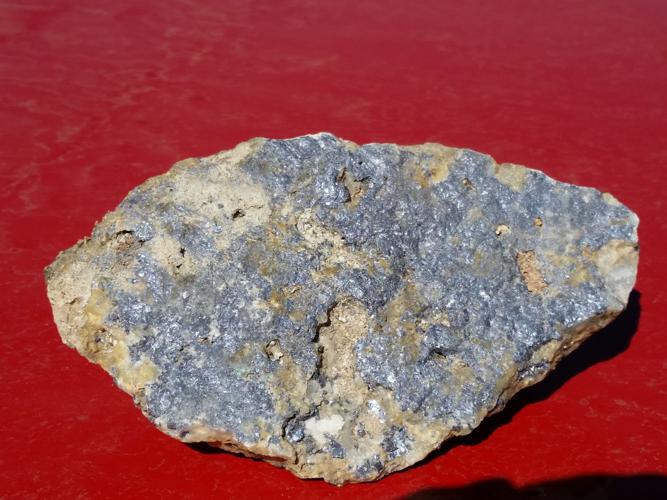Swedish chemist Peter Jacob Hjelm is credited with having isolated the element molybdenum (Mo) in 1781.
Upon further analysis, Hjelm was able to differentiate the compound of molybdenum disulfide from graphite. Characteristics of molybdenum include a high melting point of 4,753 degrees and resistance to corrosion.
Molybdenum is often found with the mineral molybdenite. A soft mineral, silvery-white in color, molybdenite takes on the appearance of graphite used in pencils; however, it has a higher specific gravity. A common ore of molybdenum contains a compound of molybdenum and sulfur (MoS2).
It also occurs with wulfenite, ferrimolybdite, ilsemannite, and jordisite.
Wulfenite is found in the oxidized portions of lead-zinc vein deposits and limestone.
Ferrimolybdite is uncommon in Arizona, but it does occur in near-surface vein deposits. The Colorado Plateau in Northern Arizona host jordisite and ilsemannite in bedded uranium deposits in sandstone.
Concentrations of molybdenum, although widespread in crustal rocks, are more concentrated in granitic rocks and nearby volcanics.
Molybdenum is associated with copper mineralization in large, low-grade “porphyry” copper deposits.
Classified as a strategic metal, it has many uses because of its ability to make alloys with other metals, including iron and steel. With chromium, it has been used in multiple industries including aircraft design, defense, electronics and nuclear energy.
Molybdenum is used in catalysts used to control the speed of chemical reactions. Molybdenum catalysts have successfully been applied in the petroleum industry as well as in polymer and plastic production.
Small amounts of molybdenum along with copper and zinc are essential to the proper functioning of the human body.
Intermittent commercial production of molybdenum in the United States began in the late 19th century. World War I saw heightened molybdenum production in Arizona, including 500,000 pounds produced in 1917.
Much of this molybdenum was produced as a primary product from wulfenite ores. Two noteworthy localities in Southern Arizona known for such production included the Mammoth-St. Anthony and the Copper Creek districts. Smaller producers included the Old Yuma Mine and the Total Wreck Mine in Pima County.
Rhenium (Re), a rare metallic element discovered in 1925, is one of the most expensive metals on Earth.
Silvery-white in appearance with a melting point of 5,767 degrees, rhenium possess a high tensile strength, resistance to wear and ductility. Its uses include an additive for high-octane gasoline and high-temperature super alloys for jet engine parts. It is also used along with tungsten in the manufacture of thermocouples and sensors used in measuring temperature.
The highest concentrations of rhenium have been found in molybdenite ranging from several tenths to 1 percent, especially when found in copper porphyry deposits. Small amounts occur with copper, iron and silver.
Recovery of rhenium necessitates its extraction from molybdenite concentrates by roasting the ore. The ore is converted to rhenium oxide (ReO3). The addition of hydrogen gas converts the rhenium oxide to pure metal.
The Sierrita Mine is a low-grade copper-molybdenum deposit that contains rhenium.
The Climax Technology Center operated by Climax Molybdenum Co. A division of Freeport-McMoRan in Sahuarita currently serves as a supplier of high-purity molybdenum metal powder.
Domestic production in the United States of molybdenum in 2015 was 56,300 metric tons valued at $1 billion.
Arizona mines including the Sierrita and Mission Mines in Pima County, Pinto Valley Mine in Gila County, Bagdad Mine in Yavapai County, and Mineral Park Mine in Mohave County have a proven track record of recovering molybdenum as a byproduct of copper mining.





